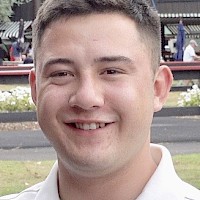
Here they are: The very strict rules for stables and training tracks to keep Covid-19 at bay
A raft of strict rules will go into immediate effect for both trainers and the operators of training centres while the Covid-19 alert level remains at four.
Both Harness Racing New Zealand and New Zealand Throughbred Racing have adopted the criteria to enable horses to be exercised during the coronavirus lockdown which starts at midnight tonight.
Approved by the Ministry Of Primary Industries, the exhaustive measures cover both hygiene and practices at the stables and procedures which training track operators must put into place to minimise the risk of the transmission of Covid-19.
Breaches of the directive will constitute a breach of the rules of racing and carry heavy penalties.
Staffing levels at both the stables and track must be reduced to a minimum and trainers and track officials will keep daily log books of the comings and goings of staff to allow contact tracing.
At the stables rigorous hygiene measures must be followed, including regular use of disinfectant on gear and hand washing by workers.
Physical distancing will be adhered to at all times at the stables and track, with two metres between workers at all times.
Clubs will allocate times for trainers to use their facilities so there are as few people as possible at any given time at the track and training will be done under supervision.
A full rundown on the orders and directions issued by HRNZ tonight follows:
Definitions
1.0 For the purpose of this Order and Direction: staff means any person working for a trainer whether paid or unpaid.
Mandatory obligations on licenced persons (trainers and stable employees and drivers)
2.0 Trainers must roster staff to reduce the numbers of staff at the stable at any one time. This may require the working day to be restructured regarding feed preparation and other daily duties.
Health assessments
3.0 Trainers must maintain assessment of the health of themselves and each of their staff. Matters that must be assessed regularly include:
3.1 Has the person been close contact with a confirmed or probable case of COVID-19?
3.2 Has the person returned from overseas travel in the last 14 days, or been in contact with another person who has returned from overseas travel in the last 14 days?
3.3 Any raised temperature or other indication of illness or fever?
3.4 Any indication of a cough, sore throat or shortness of breath?
If any one of the above four questions is a ‘yes’ then the person should revert to self-isolation, for at least a further 14 days.
Personal responsibility
4.0 A trainer and any staff must self isolate, and not attend and be refused access to stables or training facilities if:
4.1 They have cold or flu symptoms, including coughing, sneezing, runny nose, headache, aches or fever;
4.2 They know or suspect that they have been in contact with a person suspected or confirmed as contracting COVID-19; or
4.3 They or a close contact has returned to NZ from overseas with the previous 14 days.
Trainers and staff
5.0 A trainer and staff engaged in the care of horses, exercising horses, or for work in stable areas must work together to understand and comply with this directive or any measures that the trainer dictates, in order to minimise the risks of transmission of COVID-19. These measures shall include but not be limited to the following:
Contact tracing
5.1 A daily log book of all on-site staff to be maintained, with inclusion of any visiting suppliers or contractors (e.g. vets/farriers or any other person);
Contractors, suppliers and persons performing essential services
5.2 A trainer must ensure any contractor, supplier, or other person visiting the property to perform an essential service is familiar with and complies with any requirements of MPI and any other governmental requirements
Hygiene measures
5.2 When exercising horses, or in stable areas, trainers and staff are required to maintain strict standards of personal hygiene:
5.3 Provision and use of disinfectant buckets and sprays, or soap and running water located throughout the stable and tie-up stalls for regular washing of hands:
5.3.1 On arrival and before departure from the workplace;
5.3.2 Before and after eating or drinking;
5.3.3 Before and after assisting another person around the horse; and
5.3.4 Before and after handling of tack or equipment that is handled by more than one person.
5.4 All persons must wash and wear clean clothes before and after work;
5.5 Wear gloves for all duties when it is practical to do so;
5.6 Use disinfectant on all gear that is used, particularly regular disinfectant of lead ropes, reins and sulkies; and
5.7 Assign a staff member to periodically disinfect surfaces that are often used such as toilets, benches, doors, gates, barrows, rakes, brooms, buckets.
Physical distancing
5.8 Person-to-person contact must be minimised, no person should be within 2 metres of another person (unless to ensure safety in attending to the horse);
5.9 Segregation of staff into small teams or pairs of workers to minimise contact or over-lapping working hours between staff groups so that if one group is required to self-isolate, the other group(s) may continue to work;
5.10 If and when non-stable staff (e.g. vets/farriers or any other person) enter stable areas, they must be maintained at a distance at least 2 metres (unless to ensure safety in attending to the horse), and be required to hand wash with soap or disinfectant on arrival and departure.
5.11 Other than for personal hygiene needs, access of staff to offices or enclosed spaces must be limited. Such measures must include:
5.11.1 only one person at a time in a tack-room or gear-room;
5.11.2 having a sole person responsible for the feed room, and all feed buckets left outside the feed-room with handles disinfected, and
5.11.3 other similar distancing for recording and administering permitted supplements, medications, or other products.
5.12 Where possible, drivers and ground staff should be separated by at least 2 meters (unless to ensure safety in attending to the horse), and it must be ensured that a vacant tie-up stall is in between stalls that are being used to gear up horses.
5.13 Trainers and staff must immediately return to residences as soon as work duties are complete.
5.14 Prohibit the socialising of staff either at or away from the workplace.
Isolation
5.15 Trainers must stand down from the roster and require self-isolation of any staff member who:
5.15.1 Is aged 70 or over; or
5.15.2 May be vulnerable to COVID-19 due to a medical condition; or
5.15.3 Answers ‘yes’ to any of the four health assessment questions in (1) above.
5.15.4 Is diagnosed or is suspected of having contracted COVID-19. In such an instance, the employer must ensure that: the staff member immediately self-isolates, follow Ministry of Health advice, and assist in contact tracing.
Compliance
5.16 The trainer and their stable staff must comply with any directions or local rules stipulated by the training centre, including:
5.16.1 Directions of hours of access to facilities and tracks;
5.16.2 Where horses must be geared up and hosed-down;
5.16.3 Decision to close certain club facilities such as: entrances, trainers huts, swimming pool, shared horse-walkers, sawdust rolls, and the like;
5.16.4 Who may use the facilities, including restrictions on horses being floated to and from the facility; and
5.16.5 Any reduction in the number of training circuits that are open for use.
The trainer and their staff must ensure that all above measures are reviewed regularly to ensure ongoing compliance.
Movement of horses under Alert Level 4:
6.0 Trainers must inform horse owners if a horse movement is to occur.
6.1 A horse may be moved between properties during COVID-19 Alert Level 4, only if the purpose of the movement is to ensure the welfare of the horse.
6.2 For clarity, this means a horse may move out of a stable property to a nearby training track for daily exercise, or to an agistment property, or to veterinary surgery; but cannot be moved from an agistment property to a training property.
Operators of training venues:
7.0 Racing clubs and other operators of training venues must:
7.1 Maintain a daily log book of all people using its facilities;
7.2 By agreement with resident trainers, allocate times for trainers to use the facility so there are as few people as possible at any given time at the track, and allocate tie-up stalls to ensure appropriate physical distancing;
7.3 Gain confidence through discussion with local trainers, that measures required in this directive are adhered to, or rectify any deficient work practices;
7.4 Erect signage to clearly prohibit access of non-authorised persons to the property;
7.5 Ensure adequate supervision (noting distancing requirements) of the facility while training facilities are utilised;
7.6 Ensure that (unless in emergency situations) club staff can perform duties at a safe physical distance from users of the facility, or at times when users have vacated specific areas;
7.7 Minimise the number of staff on the facility, provided that this does not jeopardise health and safety of staff or persons permitted to be on-site;
7.8 Prohibit the socialising of staff either at or away from the facility; and
7.9 Consider and implement any further local rules that ensure hygiene, physical distancing, and contact tracing that will further limit the potential risk of COVID-19 transmission.
More news in Harness
It’s an even line-up but stick with fleet-footed Debbie Lincoln at Auckland on Friday night
All hail Debbie, the new speed queen of Alex Park, as she tackles a mile from the pole
Ray reaches for the half hopples to keep Whats Up The Hill trotting at Cambridge on Thursday
Debbie Lincoln’s sizzling win has namesake Debbie Green excited about the future
Our runners this week: How our trainers rate them

Nathan’s comments
Thurday night at Cambridge
Race 2: Dreams Of Eric
6.03pm
“He’s just come back from a two-week break and seems a lot better after the freshen-up. He’s training really well but this will be like a trial for him. There looks to be a lot of speed in the race so, from five, he won’t be put into the early rush. We’re still aiming him at the Harness 5000 at Ashburton in December.”

Ray’s comments
Friday night at Auckland
Race 1: Kevin Kline
4.44pm
“He was held up last week but still got home really well, hard on their backs and, with the right trip, he’ll be dangerous. But the race looks suited to a horse like Hooray Henry who, in a small field, can sit back and outsprint them.
Race 9: Tyson
8.54pm
“We were looking to sit in with him last week but it didn’t work out. He still ran on pretty well as he always does. He just needs a bit of luck.”
Race 9: Debbie Lincoln
8.54pm
“Maurice was happy with her run last week and said she paced strongly through the line. From seven on the gate this week she’ll have to go back but I think she’s better coming from off the pace. She’s a good chance if she can get sucked into it at the right time.”


